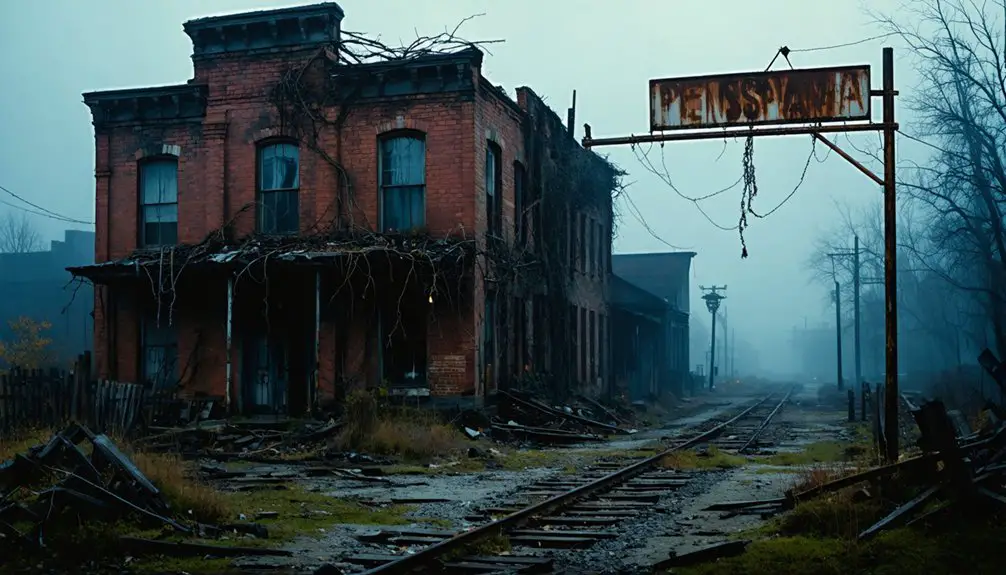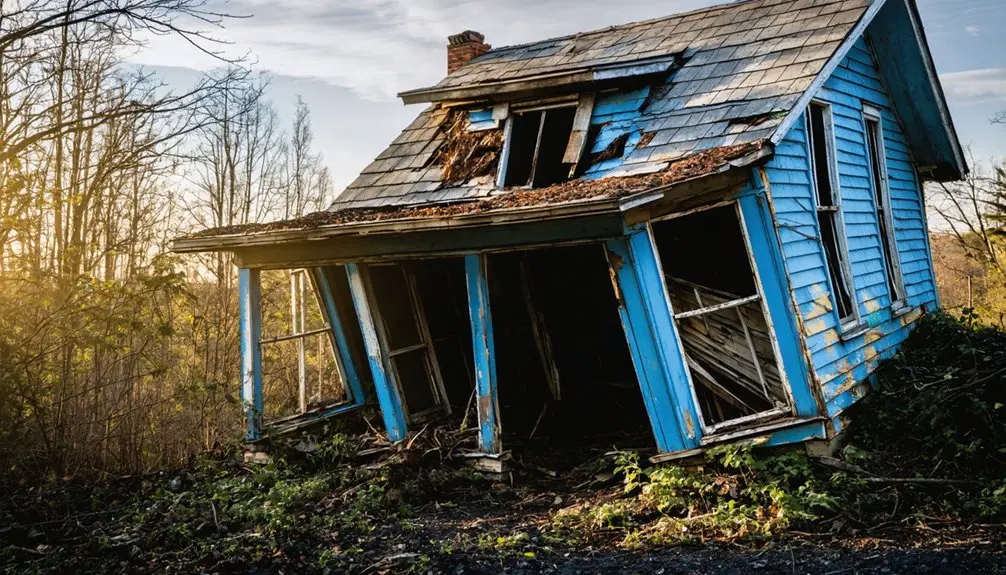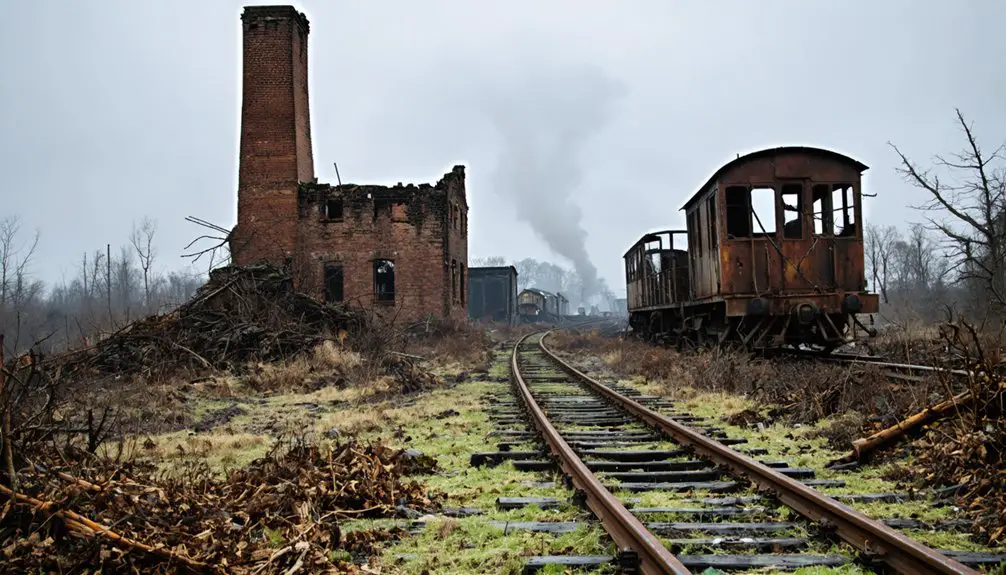You’ll find Metcalf, Pennsylvania as a haunting reminder of America’s industrial decline. This former coal mining boomtown, which once housed 5,000 residents, now stands nearly abandoned due to an underground mine fire that’s burned since 1962. The town’s collapse led to massive relocations in the 1980s, leaving fewer than 10 residents today. Beyond its ghostly streets and demolished buildings lies a complex story of environmental disaster, corporate control, and forced exodus.
Key Takeaways
- Metcalf transformed from a thriving mining town with 5,000 residents to a ghost town due to underground coal fires and environmental hazards.
- The Pennsylvania government’s relocation program in the 1980s reduced the population from over 1,000 to fewer than 10 residents.
- An underground fire ignited in 1962 continues to burn, creating toxic gas emissions and dangerous land subsidence throughout the area.
- Over 500 buildings were demolished due to unstable ground, while the remaining structures attract ghost town tourists and urban explorers.
- The town’s abandonment includes closed schools, businesses, and post office, with the fire expected to burn for another 250+ years.
The Rise and Fall of Metcalf’s Mining Era
When early miner Metcalf discovered copper deposits in eastern Arizona in 1872, he couldn’t have known his small Longfellow mine would spark the creation of a bustling mining town bearing his name.
After selling to the Leszynsky brothers, mining innovations transformed the operation with water jacket smelters replacing traditional furnaces.
The Leszynsky brothers revolutionized local mining by introducing water jacket smelters, modernizing operations beyond basic furnace techniques.
You’d have witnessed a remarkable economic boom when the Arizona Copper Company took control in 1882, implementing narrow-gauge railroads and gravity incline systems to transport ore efficiently.
The town flourished, growing to 5,000 residents at its peak, with the Longfellow mine driving prosperity. Like Pennsylvania’s early mines that used the room-and-pillar method, Metcalf’s operations relied on careful engineering to extract minerals. The thriving community boasted a bank and school, along with various amenities for residents.
Yet the mining era’s success wouldn’t last forever. The Great Depression dealt a crushing blow, forcing mine closures and triggering an exodus.
Life in a Coal Company Town
If you’d lived in Metcalf during its mining heyday, you’d have found every aspect of your daily life controlled by the coal company, from the house you rented to the store where you bought your groceries.
You would’ve faced the constant risks of mine accidents while earning modest wages that were heavily reduced by company-mandated deductions for rent, medical care, and supplies. You could only use company-issued scrip at the store, trapping many families in a cycle of debt.
Your family’s survival would’ve depended on the company store’s credit system and the regular paychecks that kept you tied to Metcalf’s dangerous but steady work. The identical houses were built in straight rows near the mine to maximize space for the growing workforce.
Mining Controls Daily Life
Though mining companies didn’t operate stores in Metcalf, they maintained tight control over nearly every other aspect of daily life in this Pennsylvania coal town.
You’d find corporate influence extending far beyond the mines themselves, shaping everything from your housing situation to local governance and social activities. Your community identity was inextricably linked to the rhythms of coal production and mining operations.
If you lived in Metcalf, you’d face the harsh reality of working dangerous underground shifts in room-and-pillar mines, often alongside fellow immigrants from Southern and Eastern Europe. The transition from charcoal to coke in the 1850s had revolutionized the region’s iron production, driving increased demand for coal mining labor. The development of the Lehigh Canal in 1818 transformed coal transport and increased mining opportunities throughout the region.
Your family’s economic survival depended entirely on the mining company’s success, and any attempts at unionization or labor protests could threaten your livelihood.
With limited mobility and few outside opportunities, you’d find yourself bound to the company’s decisions and demands.
Company Housing and Stores
The coal companies’ grip on miners’ lives extended beyond the workplace through their near-total control of housing and commerce in Metcalf.
You’d find yourself living in hastily constructed company housing, built within weeks to keep you close to the mines. The company store would be your lifeline, but it’d also be your financial trap, with higher prices and credit systems designed to keep you dependent on your employer. Unlike most mining towns, some companies like Merchants Coal built sturdy stone and brick homes to protect against fires.
- Simple, identical houses lined the streets, built cheaply to minimize company costs
- You’d use company scrip or tokens instead of real money at the store
- Indoor plumbing and electricity were rare luxuries in “model” towns
- Store credit often led to inescapable debt cycles
- Housing assignments could reflect ethnic or racial hierarchies within the community
Workers Face Safety Risks
Working in Metcalf’s coal mines meant facing death or serious injury on a daily basis, as miners confronted hazardous conditions including cave-ins, explosions, and toxic gas exposure.
You’d enter dark tunnels with minimal worker safety equipment, knowing that weak mining regulations left you vulnerable to accidents from dangerous machinery and unstable mine structures.
The constant exposure to coal dust would gradually destroy your lungs, leading to black lung disease and chronic respiratory problems. Coal police officers strictly enforced company rules and controlled miners’ movements, even during safety emergencies.
You’d bring these hazards home too, as coal dust on your clothing exposed your family to the same health risks.
The psychological burden weighed heavily, as you’d witness fellow miners suffer injuries or die in accidents.
Despite these dangers, you’d little choice but to continue working to support your family in this company-controlled environment.
Environmental Devastation and Hazards
While Metcalf’s industrial legacy brought economic prosperity during its peak years, devastating environmental consequences have plagued this Pennsylvania ghost town for decades.
Behind Metcalf’s former industrial wealth lies decades of environmental devastation, transforming a thriving town into an abandoned wasteland.
You’ll find a toxic legacy of contamination from the Max Environmental hazardous waste landfill, which operated for over 40 years with frequent EPA violations. The fight for environmental justice continues as treated wastewater with yellow tint and strong odors flows into Sewickley Creek, threatening the Youghiogheny River’s ecosystem. Recent EPA inspections uncovered rusted open containers and inadequate hazardous waste containment practices at the facility. Like the nearby town of Centralia, the area suffers from dangerous underground coal fires that have burned for decades.
- Underground mine fires release dangerous gases and destabilize the ground
- Heavy metal contamination from mining waste affects soil and air quality
- Elevated blood lead levels pose serious health risks, especially to children
- Water bodies show signs of chemical pollution and biological degradation
- Land subsidence and toxic gas emissions create ongoing safety hazards
Forced Exodus and Relocation Programs

Environmental hazards in Metcalf soon forced a dramatic demographic shift that would permanently alter the town’s fate.
You’ll find that during the early 1980s, the Pennsylvania government initiated property condemnations and buyout programs, offering residents a chance to escape the dangers of underground fires.
The exodus created deep community fragmentation, with the population dropping from over 1,000 to fewer than a dozen by the mid-1990s. Many families faced emotional turmoil as they grappled with difficult choices – some refused to leave their heritage behind, while others reluctantly departed due to health concerns.
The government’s relocation assistance ended in 2005, leaving remaining residents without formal support. Property values plummeted, and the closure of schools, businesses, and the post office accelerated the town’s abandonment, forever changing the social fabric of this once-thriving community.
Ghost Town Tourism and Urban Exploration
Despite its tragic decline, Metcalf has emerged as a compelling destination for ghost town enthusiasts and urban explorers drawn to its haunting landscape of abandoned streets and structural remnants.
You’ll find a stark representation of Pennsylvania’s industrial past, where careful exploration reveals the stories of generations who once called this place home. Like Centralia, Metcalf’s abandoned infrastructure offers unique opportunities for documenting and understanding urban decay while demanding respect for safety protocols.
- Ground instability and environmental hazards require protective equipment and extreme caution
- Local guides occasionally offer historical tours highlighting the town’s mining heritage
- Photography and videography have helped preserve Metcalf’s legacy online
- Visitors often discover artifacts and structural remains that tell stories of former residents
- Tourism has created educational opportunities about industrial decline’s long-term impacts
Preservation Efforts and Historical Significance

The preservation of Metcalf’s history faces unique challenges as most physical structures have been lost to expanded mining operations.
You’ll find that preservation efforts now focus primarily on historical documentation rather than physical restoration, with regional mining histories and ghost town registries serving as the main repositories of Metcalf’s legacy.
The town’s story mirrors the typical lifecycle of Pennsylvania coal communities – from rapid growth to eventual abandonment.
While you can’t visit original structures today, you’ll discover Metcalf’s significance through academic archives and modern media, including YouTube documentaries that highlight its peak population of 4,000-5,000 residents and amenities like banks, schools, and theaters.
These records preserve the vital narrative of how mining towns shaped Pennsylvania’s economic and social landscape during the early 20th century.
The Underground Fire’s Lasting Legacy
When an underground fire ignited in 1962 near Metcalf’s coal mines, no one could have predicted its devastating and permanent impact on the region.
This inferno’s lasting legacy continues to shape the landscape and community, transforming a once-thriving coal town into a haunting reminder of industrial catastrophe.
You’ll find the underground fire’s effects have permanently altered both the physical and social fabric of the area.
- Toxic gases still vent through ground fissures, making large portions uninhabitable
- Population plummeted from 1,400 to fewer than 10 residents
- Over $42 million spent on relocating displaced families
- More than 500 buildings demolished due to unstable ground
- The fire’s expected to burn for another 250+ years, preventing future development
Frequently Asked Questions
What Protective Gear Should Visitors Wear When Exploring Metcalf’s Ruins?
You’ll need essential gear like sturdy boots, thick gloves, and safety equipment including a helmet, respirator, and protective eyewear. Don’t forget your trekking pole and toxic gas detector.
Are There Any Surviving Descendants of Original Metcalf Residents Still Living Nearby?
You’ll find it challenging to confirm any nearby descendants, as historical records don’t conclusively document family connections after Metcalf’s abandonment during the Great Depression’s mining decline.
How Deep Underground Is the Coal Fire Burning?
You’ll find the coal fire burning at depths of up to 300 feet beneath your feet, with underground heat penetrating through abandoned mine networks that stretch across 3,700 acres of terrain.
What Wildlife Has Returned to the Abandoned Town Site?
You’ll spot white-tailed deer, wild turkeys, and coyotes roaming freely through nature’s reclaimed streets. The ecological recovery’s brought back foxes, beavers, and various songbirds to this rewilded sanctuary.
Can Visitors Legally Collect Artifacts From Metcalf’s Abandoned Buildings?
You can’t legally collect artifacts from abandoned buildings – it’s considered theft and trespassing. The artifact ethics and legal ramifications include fines and prosecution under Pennsylvania’s cultural preservation and property laws.
References
- https://pabucketlist.com/the-rise-and-fall-of-centralia-pas-toxic-ghost-town/
- https://www.youtube.com/watch?v=Qj5LjacccJ0
- https://www.youtube.com/watch?v=NcDbPf4pkCA
- https://www.youtube.com/watch?v=fm3wxSOqlYM
- https://en.wikipedia.org/wiki/Centralia
- https://winfirst.wixsite.com/arizonamininghistory/metcalf-1
- https://www.pa.gov/agencies/dep/programs-and-services/mining/bureau-of-mining-programs/pa-mining-history.html
- https://en.wikipedia.org/wiki/History_of_anthracite_coal_mining_in_Pennsylvania
- https://pophistorydig.com/topics/tag/lee-metcalf-strip-mining/
- https://www.youtube.com/watch?v=z72KgmzhMtU



